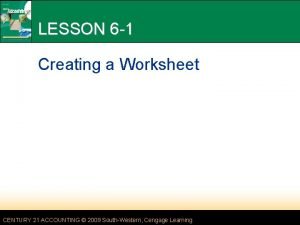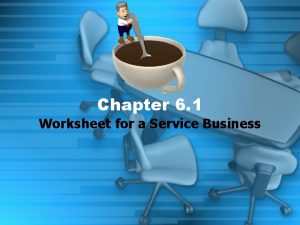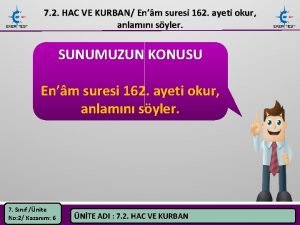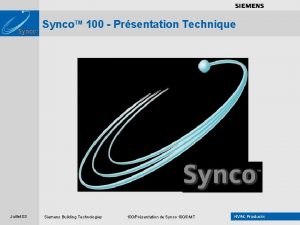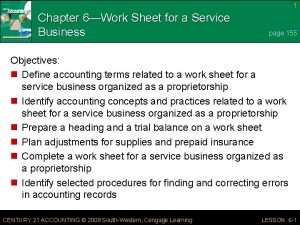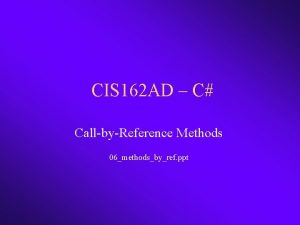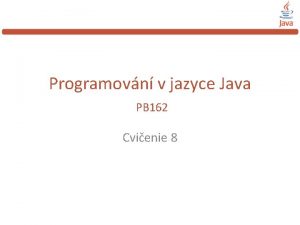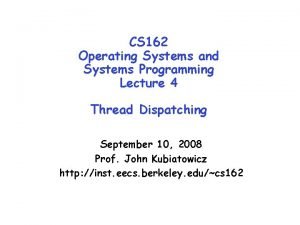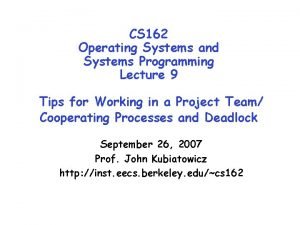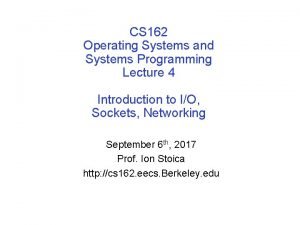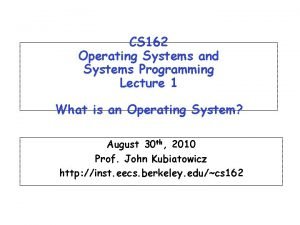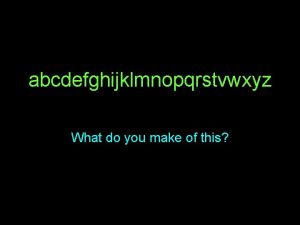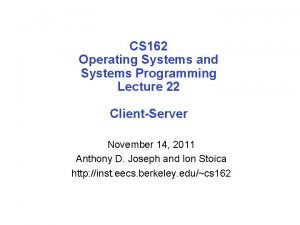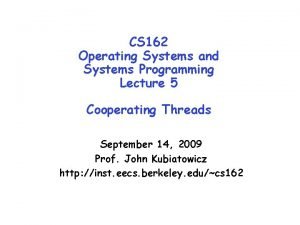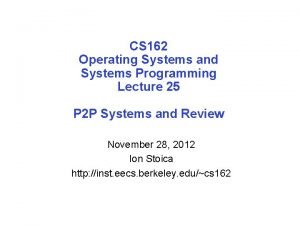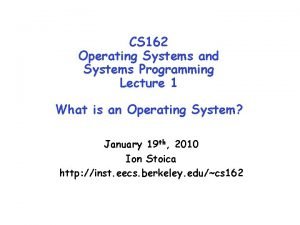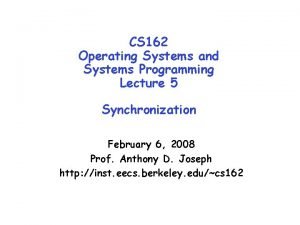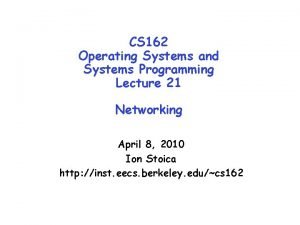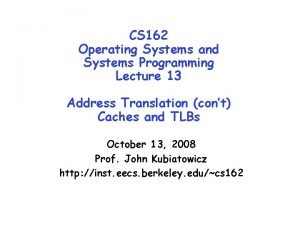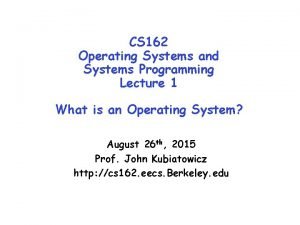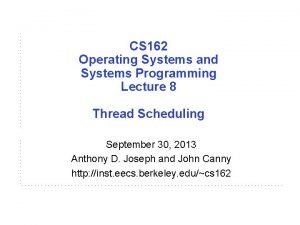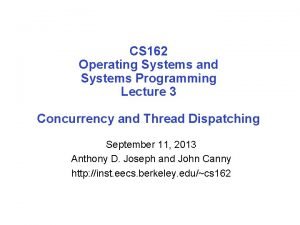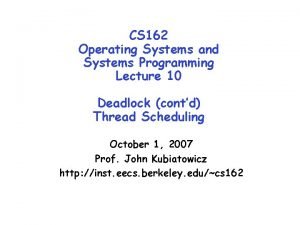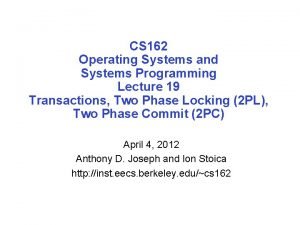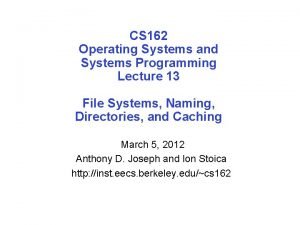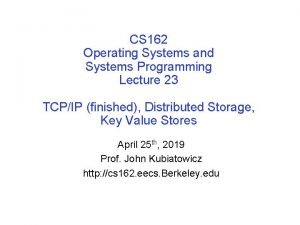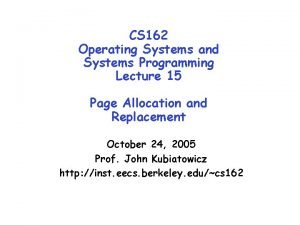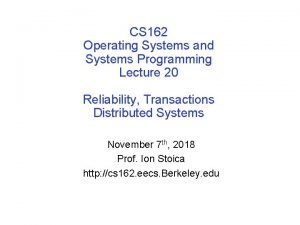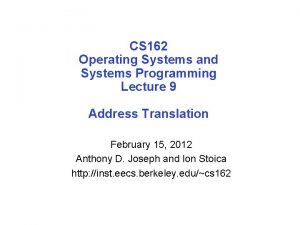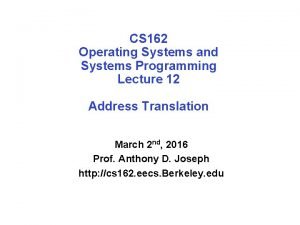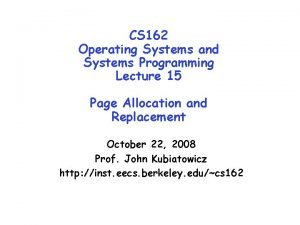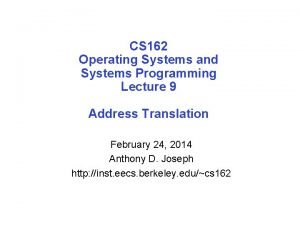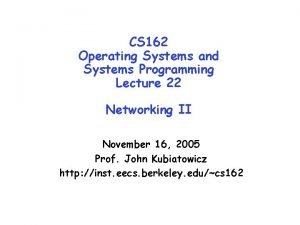CS 162 Operating Systems and Systems Programming Lecture































- Slides: 31

CS 162 Operating Systems and Systems Programming Lecture 24 Distributed File Systems November 24, 2010 Prof. John Kubiatowicz http: //inst. eecs. berkeley. edu/~cs 162

Review: Two-Phase Commit • Since we can’t solve the General’s Paradox (i. e. simultaneous action), let’s solve a related problem – Distributed transaction: Two machines agree to do something, or not do it, atomically • Two-Phase Commit protocol does this – Use a persistent, stable log on each machine to keep track of whether commit has happened » If a machine crashes, when it wakes up it first checks its log to recover state of world at time of crash – Prepare Phase: » The global coordinator requests that all participants will promise to commit or rollback the transaction » Participants record promise in log, then acknowledge » If anyone votes to abort, coordinator writes “Abort” in its log and tells everyone to abort; each records “Abort” in log – Commit Phase: » After all participants respond that they are prepared, then the coordinator writes “Commit” to its log » Then asks all nodes to commit; they respond with ack » After receive acks, coordinator writes “Got Commit” to log – Log can be used to complete this process such that all machines either commit or don’t commit 11/26/10 Kubiatowicz CS 162 ©UCB Fall 2010 Lec 24. 2

Review: Distributed Decision Making Discussion • Why is distributed decision making desirable? – Fault Tolerance! – A group of machines can come to a decision even if one or more of them fail during the process » Simple failure mode called “failstop” (different modes later) – After decision made, result recorded in multiple places • Undesirable feature of Two-Phase Commit: Blocking – One machine can be stalled until another site recovers: » Site B writes “prepared to commit” record to its log, sends a “yes” vote to the coordinator (site A) and crashes » Site A crashes » Site B wakes up, check its log, and realizes that it has voted “yes” on the update. It sends a message to site A asking what happened. At this point, B cannot decide to abort, because update may have committed » B is blocked until A comes back – A blocked site holds resources (locks on updated items, pages pinned in memory, etc) until learns fate of update • Alternative: There alternatives such as “Three Phase Commit” which don’t have this blocking problem • What happens if one or more of the nodes is malicious? – Malicious: attempting to compromise the decision making 11/26/10 Kubiatowicz CS 162 ©UCB Fall 2010 Lec 24. 3

Goals for Today • Finish Distributed decision-making discussion • Remote Procedure Call • Examples of Distributed File Systems – Cache Coherence Protocols for file systems Note: Some slides and/or pictures in the following are adapted from slides © 2005 Silberschatz, Galvin, and Gagne. Slides on Testing from George Necula (CS 169) Many slides generated from my lecture notes by Kubiatowicz. 11/26/10 Kubiatowicz CS 162 ©UCB Fall 2010 Lec 24. 4

Byzantine General’s Problem Lieutenant k! c tta A Att ack tac General k! ack ! ! Retreat! Attack! At Attack! ! treat Re Lieutenant k! Attac Malicious! Lieutenant • Byazantine General’s Problem (n players): – One General – n-1 Lieutenants – Some number of these (f) can be insane or malicious • The commanding general must send an order to his n-1 lieutenants such that: – IC 1: All loyal lieutenants obey the same order – IC 2: If the commanding general is loyal, then all loyal lieutenants obey the order he sends 11/26/10 Kubiatowicz CS 162 ©UCB Fall 2010 Lec 24. 5

Byzantine General’s Problem (con’t) • Impossibility Results: – Cannot solve Byzantine General’s Problem with n=3 because one malicious player can mess up things Attack! General Retreat! Lieutenant Retreat! – With f faults, need n > 3 f to solve problem • Various algorithms exist to solve problem – Original algorithm has #messages exponential in n – Newer algorithms have message complexity O(n 2) » One from MIT, for instance (Castro and Liskov, 1999) • Use of BFT (Byzantine Fault Tolerance) algorithm – Allow multiple machines to make a coordinated decision even if some subset of them (< n/3 ) are malicious Request 11/26/10 Distributed Decision Kubiatowicz CS 162 ©UCB Fall 2010 Lec 24. 6

Remote Procedure Call • Raw messaging is a bit too low-level for programming – Must wrap up information into message at source – Must decide what to do with message at destination – May need to sit and wait for multiple messages to arrive • Better option: Remote Procedure Call (RPC) – Calls a procedure on a remote machine – Client calls: remote. File. System Read(“rutabaga”); – Translated automatically into call on server: file. Sys Read(“rutabaga”); • Implementation: – Request-response message passing (under covers!) – “Stub” provides glue on client/server » Client stub is responsible for “marshalling” arguments and “unmarshalling” the return values » Server-side stub is responsible for “unmarshalling” arguments and “marshalling” the return values. • Marshalling involves (depending on system) – Converting values to a canonical form, serializing objects, copying arguments passed by reference, etc. 11/26/10 Kubiatowicz CS 162 ©UCB Fall 2010 Lec 24. 7

RPC Information Flow call return Machine B Server (callee) 11/26/10 return call bundle ret vals Server Stub unbundle args send receive Kubiatowicz CS 162 ©UCB Fall 2010 Network Machine A send Packet Client Handler Stub receive unbundle mbox 2 ret vals Network Client (caller) bundle args mbox 1 Packet Handler Lec 24. 8

RPC Details • Equivalence with regular procedure call – – Parameters Request Message Result Reply message Name of Procedure: Passed in request message Return Address: mbox 2 (client return mail box) • Stub generator: Compiler that generates stubs – Input: interface definitions in an “interface definition language (IDL)” » Contains, among other things, types of arguments/return – Output: stub code in the appropriate source language » Code for client to pack message, send it off, wait for result, unpack result and return to caller » Code for server to unpack message, call procedure, pack results, send them off • Cross-platform issues: – What if client/server machines are different architectures or in different languages? » Convert everything to/from some canonical form » Tag every item with an indication of how it is encoded (avoids unnecessary conversions). 11/26/10 Kubiatowicz CS 162 ©UCB Fall 2010 Lec 24. 9

RPC Details (continued) • How does client know which mbox to send to? – Need to translate name of remote service into network endpoint (Remote machine, port, possibly other info) – Binding: the process of converting a user-visible name into a network endpoint » This is another word for “naming” at network level » Static: fixed at compile time » Dynamic: performed at runtime • Dynamic Binding – Most RPC systems use dynamic binding via name service » Name service provides dynamic translation of service mbox – Why dynamic binding? » Access control: check who is permitted to access service » Fail-over: If server fails, use a different one • What if there are multiple servers? – Could give flexibility at binding time » Choose unloaded server for each new client – Could provide same mbox (router level redirect) » Choose unloaded server for each new request » Only works if no state carried from one call to next • What if multiple clients? – Pass pointer to client-specific return mbox in request 11/26/10 Kubiatowicz CS 162 ©UCB Fall 2010 Lec 24. 10

Problems with RPC • Non-Atomic failures – Different failure modes in distributed system than on a single machine – Consider many different types of failures » User-level bug causes address space to crash » Machine failure, kernel bug causes all processes on same machine to fail » Some machine is compromised by malicious party – Before RPC: whole system would crash/die – After RPC: One machine crashes/compromised while others keep working – Can easily result in inconsistent view of the world » Did my cached data get written back or not? » Did server do what I requested or not? – Answer? Distributed transactions/Byzantine Commit • Performance – Cost of Procedure call « same-machine RPC « network RPC – Means programmers must be aware that RPC is not free » Caching can help, but may make failure handling complex 11/26/10 Kubiatowicz CS 162 ©UCB Fall 2010 Lec 24. 11

Cross-Domain Communication/Location Transparency • How do address spaces communicate with one another? – – Shared Memory with Semaphores, monitors, etc… File System Pipes (1 -way communication) “Remote” procedure call (2 -way communication) • RPC’s can be used to communicate between address spaces on different machines or the same machine – Services can be run wherever it’s most appropriate – Access to local and remote services looks the same • Examples of modern RPC systems: – CORBA (Common Object Request Broker Architecture) – DCOM (Distributed COM) – RMI (Java Remote Method Invocation) 11/26/10 Kubiatowicz CS 162 ©UCB Fall 2010 Lec 24. 12

Microkernel operating systems • Example: split kernel into application-level servers. – File system looks remote, even though on same machine App file system VM App Windowing Networking Threads Monolithic Structure App RPC File sys windows address spaces threads Microkernel Structure • Why split the OS into separate domains? – Fault isolation: bugs are more isolated (build a firewall) – Enforces modularity: allows incremental upgrades of pieces of software (client or server) – Location transparent: service can be local or remote » For example in the X windowing system: Each X client can be on a separate machine from X server; Neither has to run on the machine with the frame buffer. 11/26/10 Kubiatowicz CS 162 ©UCB Fall 2010 Lec 24. 13

Administrivia • Project 4 design document: – Extension to Wednesday night – Design reviews Monday/Tuesday after Thanksgiving – Final Project code due: Tuesday 12/7 • Final Exam – Thursday 12/16, 8: 00 AM-11: 00 AM, 10 Evans – All material from the course » With slightly more focus on second half, but you are still responsible for all the material – Two sheets of notes, both sides – Will need dumb calculator (No phones, devices with net) • Optional Final Lecture: Monday 12/6 – You have until tomorrow to send me topics…. 11/26/10 Kubiatowicz CS 162 ©UCB Fall 2010 Lec 24. 14

Distributed File Systems Read File Network Client Data • Distributed File System: Server – Transparent access to files stored on a remote disk • Naming choices (always an issue): – Hostname: localname: Name files explicitly » No location or migration transparency – Mounting of remote file systems mount kubi: /jane » System manager mounts remote file system by giving name and local mount point » Transparent to user: all reads and writes look like local reads and writes to user e. g. /users/sue/foo on server – A single, global name space: every file in the world has unique name » Location Transparency: servers can change and files can move without involving user 11/26/10 mount coeus: /sue Kubiatowicz CS 162 ©UCB Fall 2010 mount kubi: /prog Lec 24. 15

Virtual File System (VFS) • VFS: Virtual abstraction similar to local file system – Instead of “inodes” has “vnodes” – Compatible with a variety of local and remote file systems » provides object-oriented way of implementing file systems • VFS allows the same system call interface (the API) to be used for different types of file systems – The API is to the VFS interface, rather than any specific type of file system 11/26/10 Kubiatowicz CS 162 ©UCB Fall 2010 Lec 24. 16

Simple Distributed File System Read (RPC) Return (Data) Client ) e it Wr C (RP Server cache K AC Client • Remote Disk: Reads and writes forwarded to server – Use RPC to translate file system calls – No local caching/can be caching at server-side • Advantage: Server provides completely consistent view of file system to multiple clients • Problems? Performance! – Going over network is slower than going to local memory – Lots of network traffic/not well pipelined – Server can be a bottleneck 11/26/10 Kubiatowicz CS 162 ©UCB Fall 2010 Lec 24. 17

Use of caching to reduce network load read(f 1) V 1 cache read(f 1) V 1 F 1: V 1 Client read(f 1) V 1 write(f 1) OK read(f 1) V 2 cache F 1: V 2 Read (RPC) Return (Data) C) P (R e t i Wr K AC Server cache F 1: V 2 F 1: V 1 Client • Idea: Use caching to reduce network load – In practice: use buffer cache at source and destination • Advantage: if open/read/write/close can be done locally, don’t need to do any network traffic…fast! • Problems: – Failure: » Client caches have data not committed at server – Cache consistency! » Client caches not consistent with server/each other 11/26/10 Kubiatowicz CS 162 ©UCB Fall 2010 Lec 24. 18

Failures Crash! • What if server crashes? Can client wait until server comes back up and continue as before? – Any data in server memory but not on disk can be lost – Shared state across RPC: What if server crashes after seek? Then, when client does “read”, it will fail – Message retries: suppose server crashes after it does UNIX “rm foo”, but before acknowledgment? » Message system will retry: send it again » How does it know not to delete it again? (could solve with two-phase commit protocol, but NFS takes a more ad hoc approach) • Stateless protocol: A protocol in which all information required to process a request is passed with request – Server keeps no state about client, except as hints to help improve performance (e. g. a cache) – Thus, if server crashes and restarted, requests can continue where left off (in many cases) • What if client crashes? – Might lose modified data in client cache 11/26/10 Kubiatowicz CS 162 ©UCB Fall 2010 Lec 24. 19

Schematic View of NFS Architecture 11/26/10 Kubiatowicz CS 162 ©UCB Fall 2010 Lec 24. 20

Network File System (NFS) • Three Layers for NFS system – UNIX file-system interface: open, read, write, close calls + file descriptors – VFS layer: distinguishes local from remote files » Calls the NFS protocol procedures for remote requests – NFS service layer: bottom layer of the architecture » Implements the NFS protocol • NFS Protocol: RPC for file operations on server – Reading/searching a directory – manipulating links and directories – accessing file attributes/reading and writing files • Write-through caching: Modified data committed to server’s disk before results are returned to the client – lose some of the advantages of caching – time to perform write() can be long – Need some mechanism for readers to eventually notice changes! (more on this later) 11/26/10 Kubiatowicz CS 162 ©UCB Fall 2010 Lec 24. 21

NFS Continued • NFS servers are stateless; each request provides all arguments require for execution – E. g. reads include information for entire operation, such as Read. At(inumber, position), not Read(openfile) – No need to perform network open() or close() on file – each operation stands on its own • Idempotent: Performing requests multiple times has same effect as performing it exactly once – Example: Server crashes between disk I/O and message send, client resend read, server does operation again – Example: Read and write file blocks: just re-read or rewrite file block – no side effects – Example: What about “remove”? NFS does operation twice and second time returns an advisory error • Failure Model: Transparent to client system – Is this a good idea? What if you are in the middle of reading a file and server crashes? – Options (NFS Provides both): » Hang until server comes back up (next week? ) » Return an error. (Of course, most applications don’t know they are talking over network) 11/26/10 Kubiatowicz CS 162 ©UCB Fall 2010 Lec 24. 22

NFS Cache consistency • NFS protocol: weak consistency – Client polls server periodically to check for changes » Polls server if data hasn’t been checked in last 3 -30 seconds (exact timeout it tunable parameter). » Thus, when file is changed on one client, server is notified, but other clients use old version of file until timeout. cache F 1 still ok? F 1: V 2 F 1: V 1 No: (F 1: V 2) C) P (R Client e rit W cache F 1: V 2 Server CK A cache F 1: V 2 Client – What if multiple clients write to same file? » In NFS, can get either version (or parts of both) » Completely arbitrary! 11/26/10 Kubiatowicz CS 162 ©UCB Fall 2010 Lec 24. 23

Sequential Ordering Constraints • What sort of cache coherence might we expect? – i. e. what if one CPU changes file, and before it’s done, another CPU reads file? • Example: Start with file contents = “A” Client 1: Client 2: Client 3: Read: gets A Read: parts of B or C Write B Read: gets A or B Write C Read: parts of B or C Time • What would we actually want? – Assume we want distributed system to behave exactly the same as if all processes are running on single system » If read finishes before write starts, get old copy » If read starts after write finishes, get new copy » Otherwise, get either new or old copy – For NFS: » If read starts more than 30 seconds after write, get new copy; otherwise, could get partial update 11/26/10 Kubiatowicz CS 162 ©UCB Fall 2010 Lec 24. 24

NFS Pros and Cons • NFS Pros: – Simple, Highly portable • NFS Cons: – Sometimes inconsistent! – Doesn’t scale to large # clients » Must keep checking to see if caches out of date » Server becomes bottleneck due to polling traffic 11/26/10 Kubiatowicz CS 162 ©UCB Fall 2010 Lec 24. 25

Andrew File System • Andrew File System (AFS, late 80’s) DCE DFS (commercial product) • Callbacks: Server records who has copy of file – On changes, server immediately tells all with old copy – No polling bandwidth (continuous checking) needed • Write through on close – Changes not propagated to server until close() – Session semantics: updates visible to other clients only after the file is closed » As a result, do not get partial writes: all or nothing! » Although, for processes on local machine, updates visible immediately to other programs who have file open • In AFS, everyone who has file open sees old version – Don’t get newer versions until reopen file 11/26/10 Kubiatowicz CS 162 ©UCB Fall 2010 Lec 24. 26

Andrew File System (con’t) • Data cached on local disk of client as well as memory – On open with a cache miss (file not on local disk): » Get file from server, set up callback with server – On write followed by close: » Send copy to server; tells all clients with copies to fetch new version from server on next open (using callbacks) • What if server crashes? Lose all callback state! – Reconstruct callback information from client: go ask everyone “who has which files cached? ” • AFS Pro: Relative to NFS, less server load: – Disk as cache more files can be cached locally – Callbacks server not involved if file is read-only • For both AFS and NFS: central server is bottleneck! – Performance: all writes server, cache misses server – Availability: Server is single point of failure – Cost: server machine’s high cost relative to workstation 11/26/10 Kubiatowicz CS 162 ©UCB Fall 2010 Lec 24. 27

World Wide Web • Key idea: graphical front-end to RPC protocol • What happens when a web server fails? – System breaks! – Solution: Transport or network-layer redirection » Invisible to applications » Can also help with scalability (load balancers) » Must handle “sessions” (e. g. , banking/e-commerce) • Initial version: no caching – Didn’t scale well – easy to overload servers 11/26/10 Kubiatowicz CS 162 ©UCB Fall 2010 Lec 24. 28

WWW Caching • Use client-side caching to reduce number of interactions between clients and servers and/or reduce the size of the interactions: – Time-to-Live (TTL) fields – HTTP “Expires” header from server – Client polling – HTTP “If-Modified-Since” request headers from clients – Server refresh – HTML “META Refresh tag” causes periodic client poll • What is the polling frequency for clients and servers? – Could be adaptive based upon a page’s age and its rate of change • Server load is still significant! 11/26/10 Kubiatowicz CS 162 ©UCB Fall 2010 Lec 24. 29

WWW Proxy Caches • Place caches in the network to reduce server load – But, increases latency in lightly loaded case – Caches near servers called “reverse proxy caches” » Offloads busy server machines – Caches at the “edges” of the network called “content distribution networks” (CDNs) » Offloads servers and reduce client latency • Challenges: – Caching static traffic easy, but only ~40% of traffic – Dynamic and multimedia is harder » Multimedia is a big win: Megabytes versus Kilobytes – Same cache consistency problems as before • Caching is changing the Internet architecture – Places functionality at higher levels of comm. protocols 11/26/10 Kubiatowicz CS 162 ©UCB Fall 2010 Lec 24. 30

Conclusion • Byzantine General’s Problem: distributed decision making with malicious failures – One general, n-1 lieutenants: some malicious (often “f” of them) – All non-malicious lieutenants must come to same decision – If general not malicious, lieutenants must follow general – Only solvable if n 3 f+1 • Remote Procedure Call (RPC): Call procedure on remote machine – Provides same interface as procedure – Automatic packing and unpacking of arguments (in stub) • VFS: Virtual File System layer – Provides mechanism which gives same system call interface for different types of file systems • Distributed File System: – Transparent access to files stored on a remote disk – Caching for performance • Cache Consistency: Keeping client caches consistent with one another – If multiple clients, some reading and some writing, how do stale cached copies get updated? – NFS: check periodically for changes – AFS: clients register callbacks to be notified by server of changes 11/26/10 Kubiatowicz CS 162 ©UCB Fall 2010 Lec 24. 31
 Operating system lecture notes
Operating system lecture notes 01:640:244 lecture notes - lecture 15: plat, idah, farad
01:640:244 lecture notes - lecture 15: plat, idah, farad C programming lecture
C programming lecture Prime factorization of 84 using exponents
Prime factorization of 84 using exponents Speed, velocity and acceleration quiz
Speed, velocity and acceleration quiz 240 scomposto in fattori primi
240 scomposto in fattori primi Hcf of 90
Hcf of 90 Como encontrar el mcd
Como encontrar el mcd Apsc 162
Apsc 162 Step diagram prime factorization
Step diagram prime factorization Komulator
Komulator What is 18/36 simplified
What is 18/36 simplified 1. 6-1 work together, p. 162
1. 6-1 work together, p. 162 6-1 work together p. 162 answers
6-1 work together p. 162 answers What is written on the three-line heading on a worksheet?
What is written on the three-line heading on a worksheet? 7 sınıf en'âm suresi 162. ayet
7 sınıf en'âm suresi 162. ayet Rle 162
Rle 162 6-4 work together p. 170
6-4 work together p. 170 Hlinex, 0,1,2,3 hlinef (x),6,18,54,162 hline
Hlinex, 0,1,2,3 hlinef (x),6,18,54,162 hline 162 ad
162 ad Pb 162
Pb 162 Cs 162
Cs 162 C++ language
C++ language Cs 162
Cs 162 Cs 162
Cs 162 Abcdefghijklmnopqrstvwxyz
Abcdefghijklmnopqrstvwxyz Perbedaan linear programming dan integer programming
Perbedaan linear programming dan integer programming Greedy vs dynamic
Greedy vs dynamic Runtime programming
Runtime programming Linear vs integer programming
Linear vs integer programming Programing adalah
Programing adalah Can we make operating systems reliable and secure
Can we make operating systems reliable and secure












